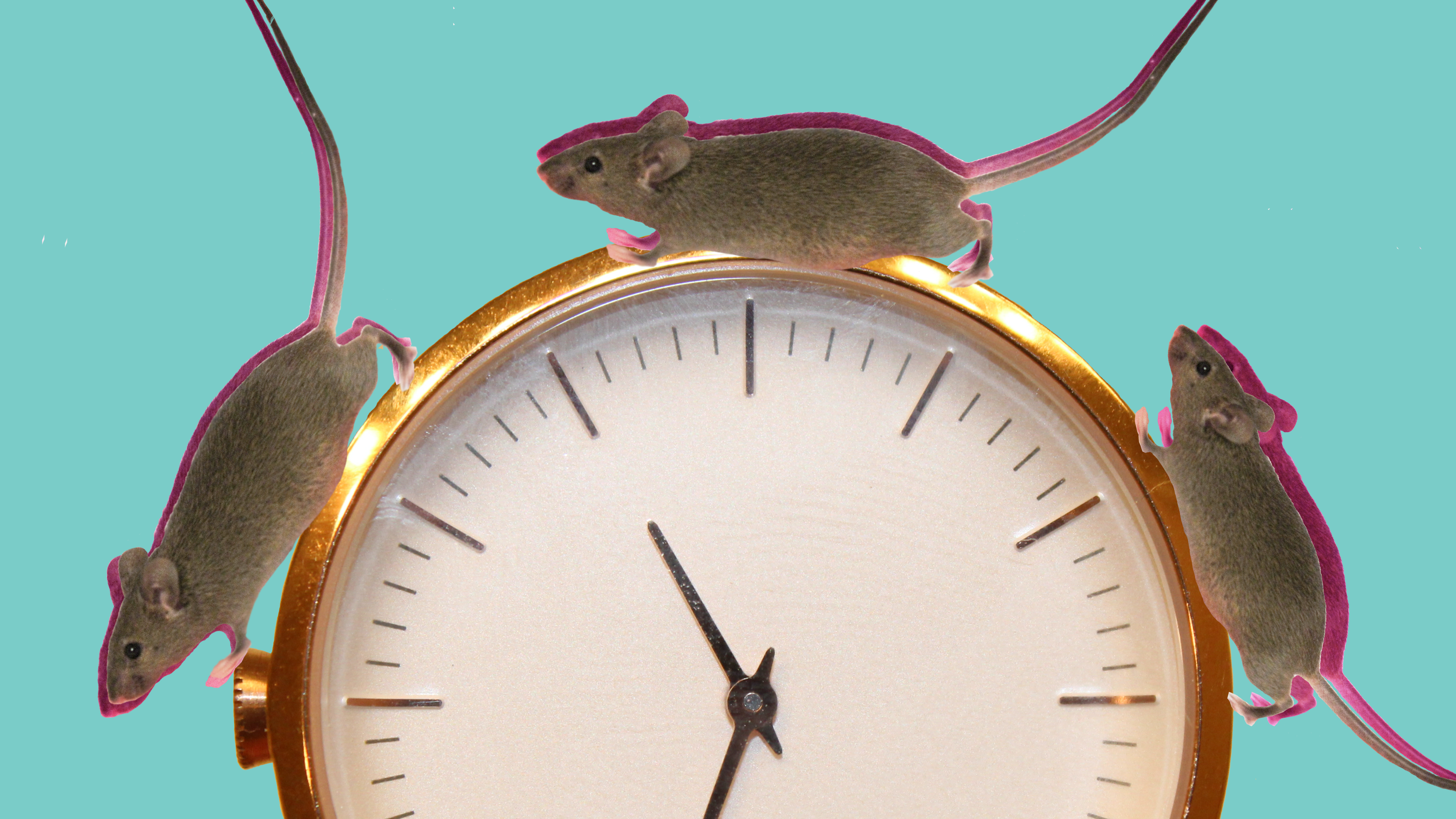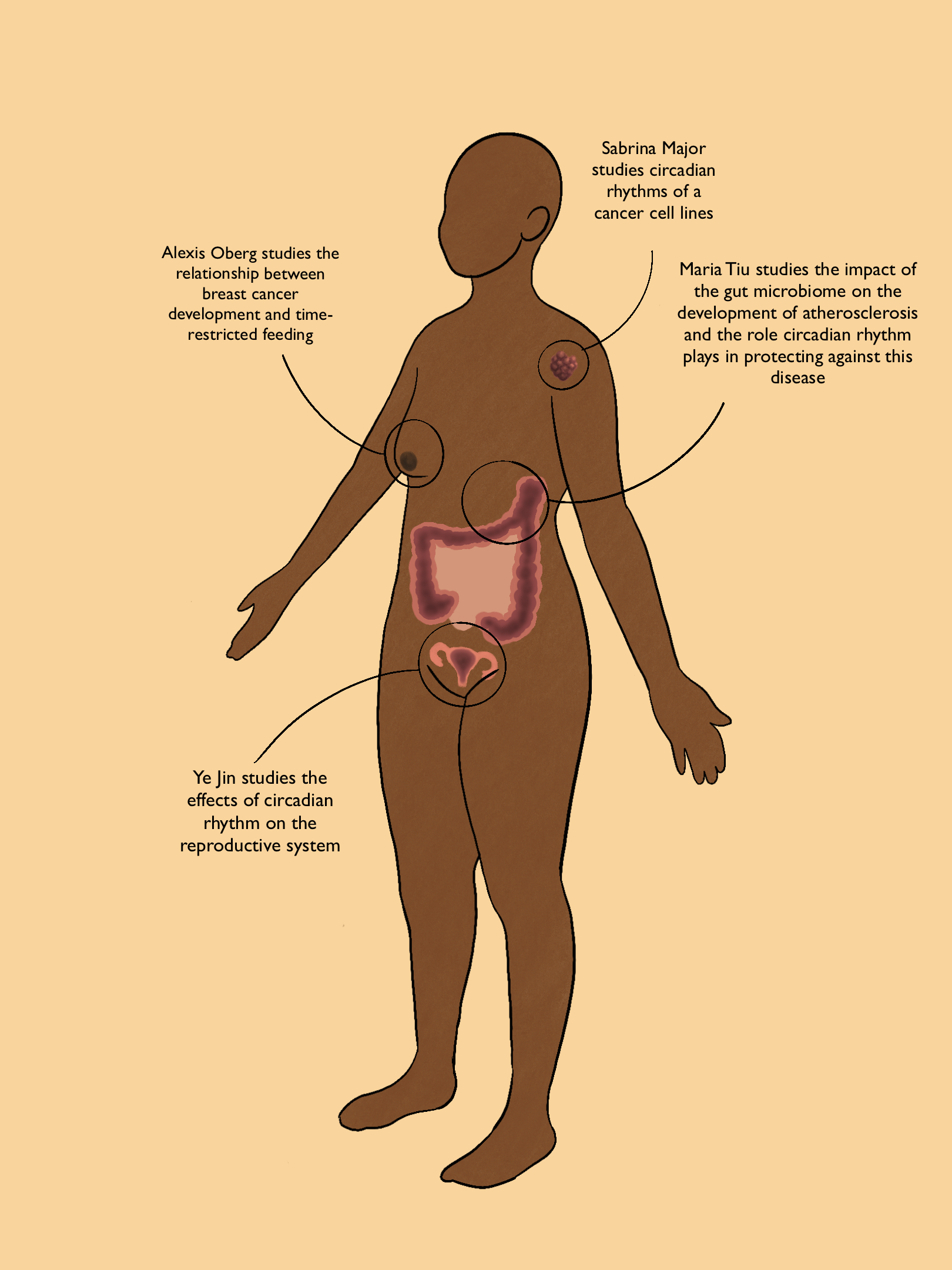Down the rabbit hole of circadian rhythms, these daily cycles are involved in cancer, digestion, and reproduction.

Our model organism (mouse) runs on a clock, our circadian rhythm stand-in.
PHOTO BY ANNE MARIE BERRY
I’m late! I’m late! For a very important date! We’ve all got a schedule to keep, and the maintenance of these schedules is what allows for the cohesive and smooth operation of one’s plans. Just like the white rabbit’s clock in Lewis Carroll’s Alice in Wonderland, our bodies schedule all of our biological processes on a 24-hour cycle, referred to as a “circadian rhythm.” This rhythm lets our bodies know when to perform certain processes and when to cease others. To maintain this biological rhythm, our bodies have a strict schedule to follow throughout the day, and our everyday actions have a strong impact on this schedule. However, some of these actions can lead to major changes in this rhythm and disrupt bodily functions, producing disastrous effects. But exactly why is this? Let’s jump down the rabbit hole and find out.
UC San Diego has a whole wonderland of research opportunities for undergraduates in various departments and programs like the Center for Circadian Biology. As we explore this wonderland of information, we will meet four undergraduate researchers who are focusing on groundbreaking circadian research during their undergraduate careers. As they help us navigate this new, undiscovered territory, you will more easily be able to understand for yourself the discoveries that lie ahead and see this new world through a scientist’s eyes.
NAVIGATING THROUGH CANCER
Our first navigator is Sabrina Major, an undergraduate researcher in Dr. Gabriele Sulli’s lab who studies the circadian rhythms of various cancer cell lines. Cancer cells maintain their own circadian rhythms which are distinct from those of healthy tissue cells. Therefore, understanding the pathways by which cancer cell circadian rhythms are formed and maintained is critical to the development of new therapeutic treatments. Because circadian rhythms are an integral part of cell maintenance, disrupting these cycles can lead to cell death which, in the case of cancer cells, is the desired outcome of treatment. Major and other researchers in the Sulli lab are testing various drugs which can disrupt circadian rhythms in cancer cells while leaving the more robust rhythms in non-cancerous cells intact. While current cancer treatments such as chemotherapy are very successful in destroying cancer cells, they also destroy healthy tissue in the process. So, new treatments which solely target cancer cells, like the ones being explored by Major and her colleagues, are extremely necessary. It is evident that Dr. Sulli’s lab is undertaking a very significant project in the field of circadian biology and cancer, and Sabrina Major is there to experience it all.
THE SCHEDULE OF FEEDING
Alexis Oberg will now show us a puzzlingly complex area of circadian study: the circadian rhythms of cancer. Studying circadian rhythms in the context of cancer development and treatment discovery by rhythm disruption continues to be an important topic in the field of circadian biology. Alexis Oberg is spending her post-graduation year in Dr. Nick Webster’s lab studying the effects of time-restricted feeding on breast cancer development in obese and post-menopausal mice. Time-restricted feeding involves designated time frames during which one either eats or fasts on a daily basis. In her project, Oberg studies mouse models that are not only on time-restricted diets, but are also only allowed to eat during a distinct eight-hour period of time. According to Oberg, previous studies have shown a correlation between disrupted circadian rhythms in the context of time-restricted feeding and various
types of cancers in post-menopausal individuals. Through the work being done in Dr. Webster’s lab, it is evident that time-restricted feeding and possible disruptions of circadian rhythms do reduce cancer growth in their mouse models; however, the exact association between disrupted circadian rhythms and cancer development is not yet clear. Alexis Oberg and her colleagues are continuing the search for a specific mechanism of action behind their findings.

Meet the student researchers who are guiding us through the mysteries of markings of circadian rhythms.
THE CYCLES OF MICROBIOME
Our next stop is the human digestive tract. Maria Tiu, a fourth-year human biology undergraduate, is conducting circadian research by delving into the world of the gut microbiome in Dr. Amir Zarrinpar’s lab. The gut microbiome encompasses the microbes located in the digestive tract that play a major role in the way food is digested. In Dr. Zarrinpar’s lab, researchers are working with mice models to understand the effect of the microbiome on the development of atherosclerosis and whether the circadian rhythm protects against this disease. Atherosclerosis is a disease in which the arteries become clogged with the build-up of plaque, blocking blood flow of oxygen-rich blood to vital organs, according to the NIH National Heart, Lung, and Blood Institute.
The Zarrinpar lab used mice models to observe circadian rhythms due to the similarities between mice and humans. Two groups of mice were observed: those that were free to eat all day and those that were on a timed feeding schedule (intermittent fasting). However, all “mice were fed an atherogenic diet,” or a diet that leads to plaque build-up in the arteries, and all the mice used were ‘Apoe -/- and Ldlr -/- mice,’ or mice that are prone to atherosclerosis. Throughout the day, the gut microbiome composition changes,” Tiu notes, and when the mice are placed on the timed feeding schedule, this “induces a circadian cycling of the microbiome.” Tiu defines the circadian rhythm to be “any biological process that has a 24-hour cycle.” However, circadian rhythms have been primarily studied during certain isolated time frames. What makes their research unique, Tiu explains, is that their data is collected during the entire 24-hour cycle.

Circadian rhythms exist everywhere in our body! Here are some tissues and organs that operate on rhythms.
In each group of mice, stool is collected every four hours and analyzed using 16s rRNA sequencing. According to CD genomics, 16s rRNA is a gene found ubiquitously in bacterial genomes; due to its abundance in bacterial DNA, gene sequencing can readily detect 16s rRNA. According to LC Sciences, the 16s gene differs between various species of bacteria, allowing for the sequencing of bacterial samples composed of many different species–such as in a gut microbiome. Therefore, this provides data about the microbes that are present at various points of the gut circadian cycle. After they complete the two week data collection period, the Zarrinpar lab stains the lesions found in mice hearts in order to determine the severity of the atherosclerosis. Looking at their heart lesions, they have noticed that mice placed on the time-restricted diet “exhibited a significant change in gut microbiome composition,” and “developed significantly less aortic lesions and significantly improved cholesterol profiles.” Overall, their findings suggest the strong role that the gut microbiome plays in the development of atherosclerosis and the effects it has on overall health.
RHYTHMS AND REPRODUCTION
Leading you through the reproductive system is Ye Jin, a third-year undergraduate researcher in Dr. Karen Tonsfeldt’s lab who is looking at the effects of circadian rhythms on the reproductive system of mice. Jin notes that the brain controls circadian rhythms, which the Tonsfeldt lab hypothesizes are controlled by certain genes. Jin defines circadians rhythms as “any ‘inner clock’ in the body which is on a 24-hour cycle.” This applies not only to something such as feeding at the same time every day, but also to the timing of the reproductive cycle, which is the focus of the Tonsfeldt Lab’s research. During the menstrual cycles of both mice and humans, body temperature rises. By taking the temperature of the mice periodically, the Tonsfeldt lab hopes to garner a correlation between this temperature and circadian rhythms as a way of measuring the menstrual cycle. Every six minutes for three weeks, they take the mice’s temperatures. Due to the large amount of information this method generates, the lab uses wavelet analysis to sort the data. According to Associate Professor Lachezar Filchev, wavelet analysis is a mathematical tool that is used to find patterns that lie hidden in large data sets, depicting the data as a graph, and allowing for a deeper understanding of this data. In the study, which uses about 100 different mice, the gene Bmal1 was knocked out so the lab could determine its effect on circadian rhythms. This gene “is a very important ‘cog’ of the molecular clock,” says Jin. It is important to the functioning of the suprachiasmatic nucleus, a region of the brain that is responsible for “coordinat[ing] the rest of the body,” essentially functioning as the body’s clock. Ultimately, the lab hopes to see the effect this knockout gene has on the mice’s circadian rhythms, as it is an integral part of the timing of many of the body’s functions.
Circadian rhythms are an exciting and relatively new area of research, the surface of which has barely been scratched by scientists. This rhythm plays a large role in many important biological processes. From eating to sleeping and even to the development of pathological diseases, circadian rhythms are a crucial background player in their cycle and perpetuation. Without circadian rhythms, our bodies would be fundamentally different. Though not much is known about circadian rhythms currently, this means there is an entire wonderland of discoveries waiting to be uncovered and explored.
WRITTEN BY LILIT VARDANYAN & LEANNE DUGAN
Lilit Vardanyan is a fourth year student majoring in Human Biology. Leanne Dugan is a second year student majoring in General Biology.
FROM UNDER THE SCOPE VOL. 11
To read the original version, please click here. To read the full version on our website, please click here. To read more individual articles, please click here.